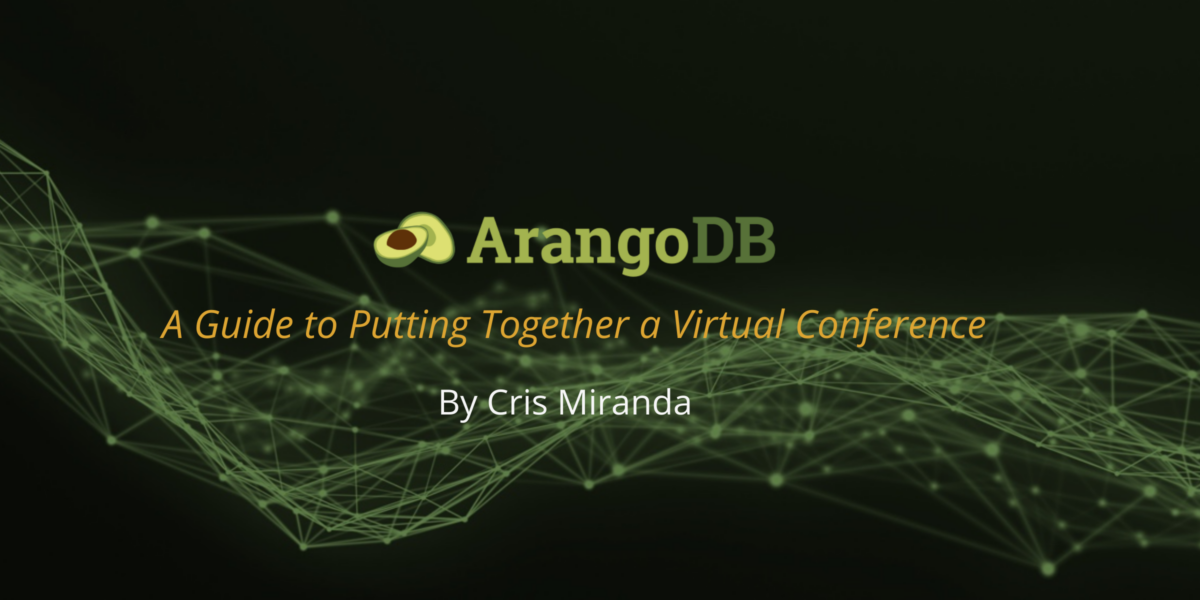A Guide to Putting Together a Virtual Conference
Estimated reading time: 7 minutes
Hello! I’m Cris Miranda, the community manager at ArangoDB, and I make sure ArangoDB has a vibrant, wholesome, and ever-growing community of amazing people. I want to share some tips and advice based on valuable lessons we’ve learned from our first-ever virtual developers’ conference.
In this short blog post, you’ll learn about how to avoid the common pitfall of ‘feature creep’ as well as gain tips on navigating virtual events platforms. I also teach you how you and your team can move together in synchronicity while keeping your goals as your guiding lighthouse. Lastly, I’ll teach you the best mindset to approach the world of rapidly changing live events. Alright, let’s get started!
(more…)October 2021: What’s the Latest with ArangoDB?
Estimated reading time: 5 minutes
Hello Community,
Welcome to the tenth ArangoDB newsletter of 2021.
This month, we are happy to be able to share:
- Our developer conference, ArangoDB Dev Days, is available on demand
- The latest and greatest from our blog about understanding GraphSage
- Our last Graph & Beyond Lunch Break, Advanced Aggregation Queries with AQL
- Community spotlight on a new notebook on ArangoDB and AQL in Portuguese (and more!)
- Our growing avocado grove (aka we are hiring!)
September 2021: What’s the Latest with ArangoDB?
Estimated reading time: 6 minutes
Hello Community,
Welcome to the ninth ArangoDB newsletter of 2021.
Nine is fine and that’s how we are feeling about this month’s news, which includes:
- Our first-ever developer conference ArangoDB Dev Days (100% virtual and free!)
- The latest from our blog about detecting complex fraud patterns
- An upcoming webinar with a guest speaker from Slack
- Community spotlight on Elixir projects (and more!)
- Our growing avocado grove (aka we are hiring!)
ArangoDB Dev Days are Here!
Estimated reading time: 2 minutes
We’ve been spending quite a bit of time preparing something really exciting for our community this year: we’re thrilled to announce ArangoDB’s first-ever virtual developer conference taking place October 18th through the 22nd, 2021.
(more…)August 2021: What’s the Latest with ArangoDB?
Estimated reading time: 6 minutes
Hello Community,
Welcome to the eighth ArangoDB newsletter of 2021. Woo hoo! Eight is great 🙌🏻
In this edition, we are excited to share:
- An upcoming webinar with a guest speaker from Slack
- A new blog post about entity resolution
- An upcoming workshop on Graph Neural Networks
- Community spotlight on the Python-Arango driver (and more!)
Our growing avocado grove (aka we are hiring!)
July 2021: What’s the Latest with ArangoDB?
Estimated reading time: 6 minutes
Hello Community,
Welcome to the seventh ArangoDB newsletter of 2021! We hope you are enjoying summer as safely as you can.
In this edition, we are excited to share:
- ArangoDB 3.8 is GA!
- A new blog post about word embeddings
- Our next Lunch Break: ArangoDB for Beginners
- Our growing avocado grove (aka we are hiring!)
June 2021: What’s the Latest with ArangoDB?
Estimated reading time: 5 minutes
Hello Community,
Welcome to the sixth ArangoDB newsletter of 2021! Hard to believe we are already half-way through 2021 🤯
In this edition, we are excited to share:
- Our next Graph & Beyond Lunch Break: Kubernetes Meets Graphs
- Developer deployments for ArangoDB ArangoGraph (NEW!)
- Our first online Meetup of 2021
- The latest blog post in our ArangoML series
- Our growing avocado grove (aka we are hiring!)
Introducing Developer Deployments on ArangoDB ArangoGraph
Estimated reading time: 4 minutes
Today we’re announcing the introduction of Developer deployments as a beta feature on the ArangoGraph platform.
In this blog post, we’ll tell you what Developer deployments are, what you can do with them, what you should not do with them, and how to get started.
(more…)ArangoBNB Data Preparation Case Study: Optimizing for Efficiency
Estimated reading time: 18 minutes
This case study covers a data exploration and analysis scenario about modeling data when migrating to ArangoDB. The topics covered in this case study include:
- Importing data into ArangoDB
- Developing Application Requirements before modeling
- Data Analysis and Exploration with AQL
This case study can hopefully be used as a guide as it shows step-by-step instructions and discusses the motivations in exploring and transforming data in preparation for a real-world application.
The information contained in this case study is derived from the development of the ArangoBnB project; a community project developed in JavaScript that is always open to new contributors. The project is an Airbnb clone with a Vue frontend and a React frontend being developed in parallel by the community. It is not necessary to download the project or be familiar with JavaScript for this guide. To see how we are using the data in a real-world project, check out the repository.
ArangoDB Newsletter #133: May Updates and Insights
Estimated reading time: 4 minutes
Hello Community,
Welcome to the fifth ArangoDB newsletter of 2021!
In this edition, we are excited to share:
- An upcoming webinar about ArangoDB 3.8
- The latest blog post in our ArangoML series
- Our next Lunch Break spotlighting Fuzzy Search
- Our growing avocado grove (aka we are hiring!)
We hope you enjoy it!
Get the latest tutorials,
blog posts and news:
Thanks for subscribing! Please check your email for further instructions.


